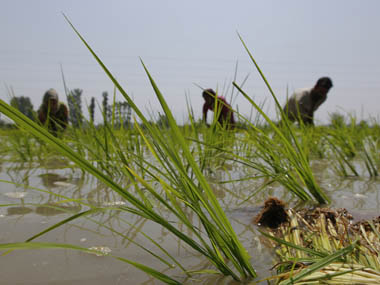Monday’s wholesale price index (WPI) number is a standing indictment of the way the government has mismanaged the food economy.
The main reason why the WPI leapt up in April to 7.23 percent -which is well outside the Reserve Bank’s comfort zone-is the return of food inflation, which is back in double digits at 10.49 percent.
Now contrast this with what is actually happening in staples: our granaries are overflowing with rice and wheat, and a lot of it will rot. According to Ashok Gulati, Chairman of the Commission for Agricultural Costs and Prices (CACP), by June 2012 our grain stocks will cross 75 million tonnes when our storage capacity is only 50 million tonnes (Read Gulati’s views here ).
Question: why are food prices zooming when food stocks are so much in excess of our needs?[caption id=“attachment_309965” align=“alignleft” width=“380” caption=“Prices are high even when grains are rotting. Reuters”]
 [/caption]
[/caption]
Two reasons why: cost-push and demand pull. Government-administered costs-set through high procurement prices in the name of helping the farmer-are pushing up open market prices in staples like rice and wheat.
Surjit Bhalla, writing in The Indian Express , blasts the CACP for recommending a 16 percent minimum support price (MSP) increase in paddy this year when the granaries are overflowing. Bhalla says that there is almost a one-to-one correlation between high MSPs and high inflation. The period of 2008-11 saw both high MSP increases and high food inflation. “On pure economic grounds, the CACP recommendation should be seen for what it is - dirty economics and dirtier politics,” says Bhalla.
But even as costs are being pushed by MSP hikes, demand is focused on protein-based foods, where there is little government action. The WPI for April shows high food inflation because of double-digit growth in milk, eggs, meat and fish, and dramatic increases in veggies and potato of 50-60 percent.
The solutions should be equally obvious: export the excess cereals, and incentivise the production of milk, eggs, etc. The second point, of course, is a medium-term solution and not easily done (read here ).
The big failure clearly relates to the excess build-up of rice and wheat stocks, which is not only straining the godown infrastructure, but also pushing up their cost by 25 percent.
Writing in The Economic Times , Gulati says the interest and storage cost of holding excess grain is 20 percent of the MSP, and to that one must add another five percent as loss through open storage - where rain may damage the food and rats may eat a part of it.
Gulati says that rice exports can be profitable, but wheat will not be, and hence it makes more sense to sell it locally, even at prices that are 15-20 percent subsidised (because the cost of storage is 25 percent). Export of wheat with a subsidy of 15 percent is another option.
Economically, all this makes sense (short-term subsidies are fine if the cost of not subsidising is higher). But consider the larger illogic of it all: farmers have to be paid more to make farming viable, but since nobody will buy the grain in the open market at that price, we have to subsidise it to get rid of the excess procured from farmers.
Alternatively, we will export wheat at a subsidy: our taxpayer will pay for someone else’s lunch.
The larger question is this: if we are producing too much rice or wheat, why do we need an expensive food security bill ? Why not allow the poor to buy the grain from either the existing public distribution system by enabling them to earn an income. Isn’t this the purpose of the Mahatma Gandhi National Rural Guarantee Act (NREGA)?
Since the accumulation of the grain mountain is not a recent phenomenon-it has been with us for three years-the only conclusion one can draw is this: the mountain is intended to feed the Food Security Bill, which will presumably get launched this year as a pre-election exercise.
Gulati can only shake his head at this nave belief in huge storage and delivery through the leaky public distribution system. He says, “Sustainable food security through public agencies cannot be achieved at low cost.”
Our takeouts are clear: Inflation is directly linked to MSPs. Combine high MSPs with the inadequate storage and wastage, and we have more cost-push, more subsidies.
As higher MSPs push Indian food costs higher than world prices-it’s already happened in wheat, and could happen in rice shortly-we would have created the perfect mess: high cost food, and subsidisation of food exports.
There is, however, a short window of opportunity this year, when the rupee has crashed and wheat subsidies may not be required - at least not much. But the government has to okay the exports urgently - when the rupee is low.
But then what have a created? A food security system for ourselves or for the world? And at our cost?
)